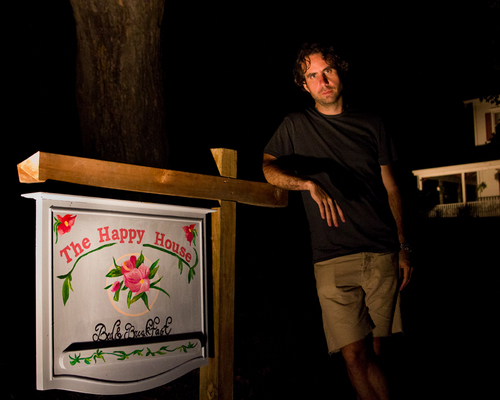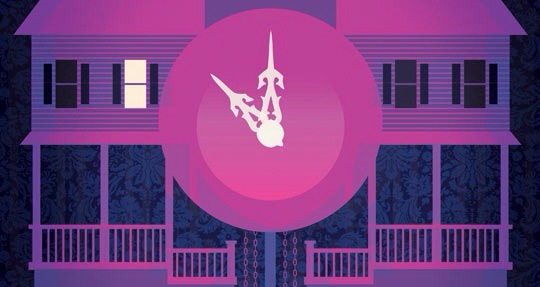
You might find it hard to pin down D.W. Young. Making a splash a few years back with his documentary A HOLE IN THE FENCE – which examined the changing fortunes of an abandoned industrial area in Red Hook, New York – Young spends much of his time as a freelance editor, while making time to direct the occasional comedic short film. With THE HAPPY HOUSE he makes his feature debut, and these varied experiences have paid off in a wonderful, unique horror/comedy that will keep audiences on their toes. Young took some time out of his busy schedule to discuss how he keeps his work grounded reality, dressing a bed & breakfast on a budget, and dealing with smart characters in a horror setting.
Sweetback (SB): THE HAPPY HOUSE is a difficult film to pin down. It’s ostensibly a horror-comedy, but very different in tone and pacing from the sort of horror-comedies that fans of genre films have come to expect. Were you consciously trying to avoid the cliches of the genre when writing it?
D.W. Young (DY): A lot of horror comedies are pretty upfront with their method. They tend to be explicitly self-conscious and direct in their poking fun at cliche. So almost immediately in, say, THE CABIN IN THE WOODS, you read the signs and get the central joke and from there on it’s mainly an ongoing development of that thread. Which works great and the enjoyment is in the inventiveness of the details. But at the end of the day you’re in a relatively comfortable place as a viewer once you latch on.
That’s one thing I wanted to play with a little bit, that sense of viewer comfort. I wanted people to be asking themselves “What movie am I really in here?”. At one point well into the film you might even be wondering if it’s going to be a horror movie at all. Which is a bit risky and probably not something you’d get to do in a big budget film. At face value the setup is absolutely by the book classic and contains many of the cliches of the genre. And there, in reference to your question, I guess I was technically embracing those cliches on one level. But I’d prefer to think of them as basic conventions because it’s really cliched response to convention that’s where things turn mediocre. It’s not like anyone is ever going to fault THE GOOD, THE BAD AND THE UGLY for ending on a shootout.
And so that kind of cliched response is what I was interested in avoiding, or at least shading differently. Structurally the film is often intentionally unorthodox – there’s a degree of rearrangement and delay that’s meant to disrupt you. The tone in particular takes a pretty sharp swerve at one point, which I’m sure won’t be acceptable to everyone, but hopefully to some people it will be reinvigorating.
SB: Without going into spoilery specifics, what I most loved about the film is the way in which it cheerfully plays with audience expectations. Even the two central characters – Joe and Wendy – seem to expect things to play out in a more traditionally horrific manner. Was it enjoyable to build in these intentional misdirections?
DY: Absolutely. I think half the pleasure of either making or watching a good genre film is having your expectations tweaked. To me the greatest sin of all is to be totally predictable. I’d love to talk about some of the subtler instances in the film but I’ll refrain for spoilers sake.
One thing we did incorporate into the movie is the degree to which we are all, in real life, conditioned to the conventions of horror movies. So obviously if your car breaks down near a lonely old motel with a really creepy desk attendant you’re going to be expecting a kitchen knife in the shower. You’ll be joking about it with your traveling companion and it probably won’t happen but you’ll probably take a few precautions just in case.
But not only do we know how to read these signs, our awareness is so culturally heightened we’re inclined to actually impose them on innocent situations. Which is why Wendy sees menace around every corner. Of course, on the flip side, it can be infuriating in some horror movies when nobody displays this basic awareness, which would easily allow them to survive or escape or bypass any danger in the first place.
Either way the fact is cinema is now like a layer of interpretation on top of reality you can’t truly ignore.
SB: Was the title THE HAPPY HOUSE a reference to the Siouxsie and the Banshees song “Happy House”? Or were you just looking for the most innocuous possible name for a Bed and Breakfast?
DY: It was the latter. But it’s also a little morsel of bait – as in nothing that sounds so innocent possibly could be. Plus a tongue in cheek joke on the fact that Wendy hates B&B’s and is fighting with her boyfriend and there doesn’t look to be much happy about their stay going into it.
SB: Can you talk a little about casting Marceline Hugot as Hildie,in the film? It’s such a sincere, even heartbreaking, performance. Much more sympathetic and nuanced than one normally gets in this sort of film. How did she get onboard?
DY: Marceline is an extremely talented actress and was an absolute pleasure to work with. She was brought in by our casting director Kim Moarefi and I thought she had a great take on Hildie. Along with her basic sweetness, Marceline has this wonderful touch of edge to her that I thought really fit the role.
To me it’s far more horrible to have a character you care about, even if it’s only a touch fondly, suffer than it is a two dimensional stock type (which often only furthers your disconnect from the actual action on screen). I think if a horror movie wants to be really powerful, that’s important, and although that level of dramatic intensity isn’t really the main function of THE HAPPY HOUSE, we wanted to achieve an unexpected moment or two of it, and Marceline is central to that .
SB: In so many horror films there’s a tendency to heighten the reality, but aside from the introduction of an escaped lunatic, things here are rooted very clearly in a recognizable world. How important was this level of restraint for maintaining the drama – and threat – for the characters?
DY: I always felt it was important. In every way the film is opposed to the superhuman. Even our seemingly larger than life serial killer is bound to the laws of reality. Everything is a bit messy and random, heroics are modest at best.
I think you need to have some degree of honesty in your characters reaction to crazy moments and violent encounters or they quickly turn comic book. Which is totally cool if that’s what you’re doing, but even then the best comic book characters work because you care about the characters, and that’s a result of a kind of honesty in their depiction, so there’s always value in playing certain things straight.
And I think it’s worth noting that nobody ever does anything really incomprehensibly stupid in the film, which can be maddening and really undermine the potency of dramatic situations on screen. They’re essentially all just victims of bad luck.

SB: The actual B&B makes for a wonderful location for the action. How did you end up getting access to it, and did it require much dressing? Those cuckoo clocks certainly make for an interesting addition.
DY: We were going to use a different place initially, but it fell through and then our location scout Stephen Harris found us this house in Upstate NY and saved the day. It’s an actual working B&B, and by a stroke of luck they had two weeks open just after the summer season and we rented it out for that stretch (we shot the film in a very fast 14 days).
Our art budget was really tiny, so we had to be very targeted with our dressing, and I think our Production Designer Greg Meola did a great job stretching it as far as he could. It’s a grand old house with much of the original detailing, so we took advantage of that as much as possible, just tilting things here and there to play up various elements. The cuckoo clocks were in the script and the one major element we added. And all the candlelight stuff is a kind of no-budget, old fashioned way of taking advantage of what darkness has to offer.
It’s funny though because its really a very normal, cheery place full of kids and life.
Not Interested – Teaser from D.W. Young on Vimeo.
SB: For those interested in checking out THE HAPPY HOUSE or your other works, what’s the best way for them to do so?
DY: THE HAPPY HOUSE just came out on iTunes, Amazon and most of the other online streaming sites, plus a fair number of cable VOD providers. Netflix and DVD will be in January. My short NOT INTERESTED, which is kind of a spiritual predecessor to the film involving a door to door knife salesman who gets into some trouble, is also on iTunes and Amazon and will be included on the DVD as a special feature.
SB: Any upcoming projects on the horizon we should be looking out for?
DY: I’m putting the final touches on a short I shot over the summer called SWEATING IN THE NIGHT, my third collaboration with Khan Baykal (who plays Joe). It’s a kind of surreal fever dream of the 80’s and high school, much more stylized than THE HAPPY HOUSE. And I have a couple of new feature scripts that I’m going to start trying to get off the ground now, one that’s a kind of noirish thriller set at a shady funeral home.
SB: While you’ve been directing shorts and documentaries for years, this is your first full length feature. What advice might you have for young or inexperienced directors looking to tackle their first feature?
DY: Well I actually came to filmmaking a bit later than most, from writing short fiction, and had only ever shot two days of narrative with the tiniest of crews before this, so it was certainly a leap in many ways. I guess I’d say that in my opinion there’s no inherently right or wrong way to make a film and be careful of anyway who tells you too insistently otherwise.
SB: Thanks for your time!
- [NO-BUDGET NIGHTMARES] PODCAST #80: PLAGA ZOMBIE (1997) - July 25, 2016
Tags: comedy, D.W. Young, Happy House, Horror, Low Budget Films, New York, Not Interested



No Comments